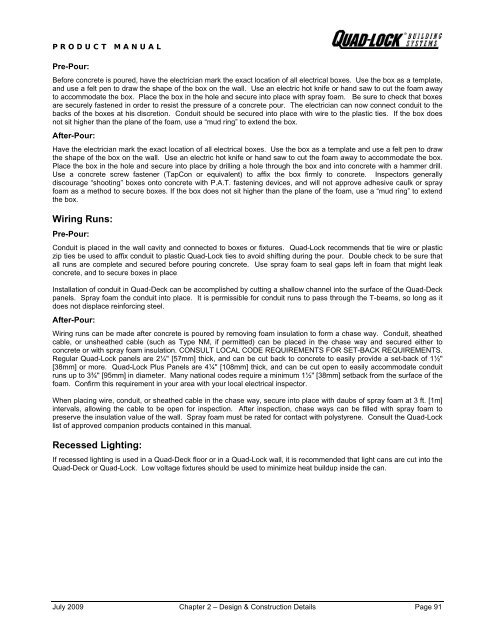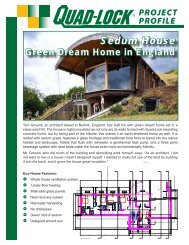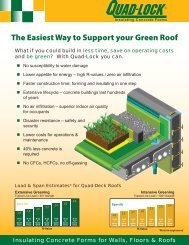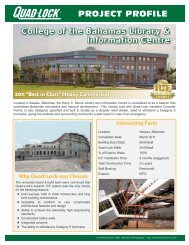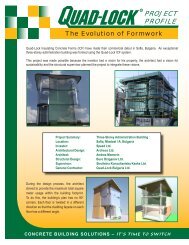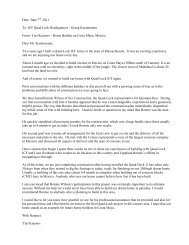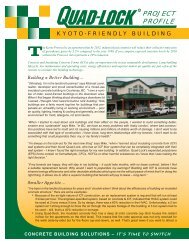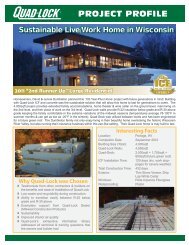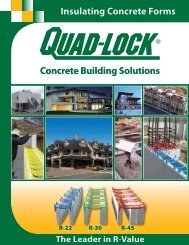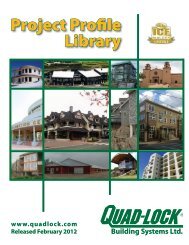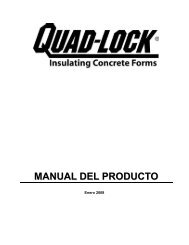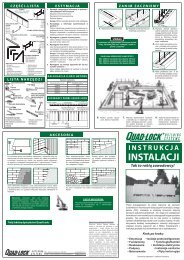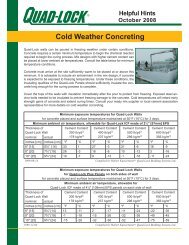Create successful ePaper yourself
Turn your PDF publications into a flip-book with our unique Google optimized e-Paper software.
PRODUCT MANUAL<br />
Pre-Pour:<br />
Before concrete is poured, have the electrician mark the exact location of all electrical boxes. Use the box as a template,<br />
and use a felt pen to draw the shape of the box on the wall. Use an electric hot knife or hand saw to cut the foam away<br />
to accommodate the box. Place the box in the hole and secure into place with spray foam. Be sure to check that boxes<br />
are securely fastened in order to resist the pressure of a concrete pour. The electrician can now connect conduit to the<br />
backs of the boxes at his discretion. Conduit should be secured into place with wire to the plastic ties. If the box does<br />
not sit higher than the plane of the foam, use a “mud ring” to extend the box.<br />
After-Pour:<br />
Have the electrician mark the exact location of all electrical boxes. Use the box as a template and use a felt pen to draw<br />
the shape of the box on the wall. Use an electric hot knife or hand saw to cut the foam away to accommodate the box.<br />
Place the box in the hole and secure into place by drilling a hole through the box and into concrete with a hammer drill.<br />
Use a concrete screw fastener (TapCon or equivalent) to affix the box firmly to concrete. Inspectors generally<br />
discourage “shooting” boxes onto concrete with P.A.T. fastening devices, and will not approve adhesive caulk or spray<br />
foam as a method to secure boxes. If the box does not sit higher than the plane of the foam, use a “mud ring” to extend<br />
the box.<br />
Wiring Runs:<br />
Pre-Pour:<br />
Conduit is placed in the wall cavity and connected to boxes or fixtures. <strong>Quad</strong>-<strong>Lock</strong> recommends that tie wire or plastic<br />
zip ties be used to affix conduit to plastic <strong>Quad</strong>-<strong>Lock</strong> ties to avoid shifting during the pour. Double check to be sure that<br />
all runs are complete and secured before pouring concrete. Use spray foam to seal gaps left in foam that might leak<br />
concrete, and to secure boxes in place<br />
Installation of conduit in <strong>Quad</strong>-Deck can be accomplished by cutting a shallow channel into the surface of the <strong>Quad</strong>-Deck<br />
panels. Spray foam the conduit into place. It is permissible for conduit runs to pass through the T-beams, so long as it<br />
does not displace reinforcing steel.<br />
After-Pour:<br />
Wiring runs can be made after concrete is poured by removing foam insulation to form a chase way. Conduit, sheathed<br />
cable, or unsheathed cable (such as Type NM, if permitted) can be placed in the chase way and secured either to<br />
concrete or with spray foam insulation. CONSULT LOCAL CODE REQUIREMENTS FOR SET-BACK REQUIREMENTS.<br />
Regular <strong>Quad</strong>-<strong>Lock</strong> panels are 2¼" [57mm] thick, and can be cut back to concrete to easily provide a set-back of 1½"<br />
[38mm] or more. <strong>Quad</strong>-<strong>Lock</strong> Plus Panels are 4¼" [108mm] thick, and can be cut open to easily accommodate conduit<br />
runs up to 3¾" [95mm] in diameter. Many national codes require a minimum 1½" [38mm] setback from the surface of the<br />
foam. Confirm this requirement in your area with your local electrical inspector.<br />
When placing wire, conduit, or sheathed cable in the chase way, secure into place with daubs of spray foam at 3 ft. [1m]<br />
intervals, allowing the cable to be open for inspection. After inspection, chase ways can be filled with spray foam to<br />
preserve the insulation value of the wall. Spray foam must be rated for contact with polystyrene. Consult the <strong>Quad</strong>-<strong>Lock</strong><br />
list of approved companion products contained in this manual.<br />
Recessed Lighting:<br />
If recessed lighting is used in a <strong>Quad</strong>-Deck floor or in a <strong>Quad</strong>-<strong>Lock</strong> wall, it is recommended that light cans are cut into the<br />
<strong>Quad</strong>-Deck or <strong>Quad</strong>-<strong>Lock</strong>. Low voltage fixtures should be used to minimize heat buildup inside the can.<br />
July 2009 Chapter 2 – Design & Construction Details Page 91


